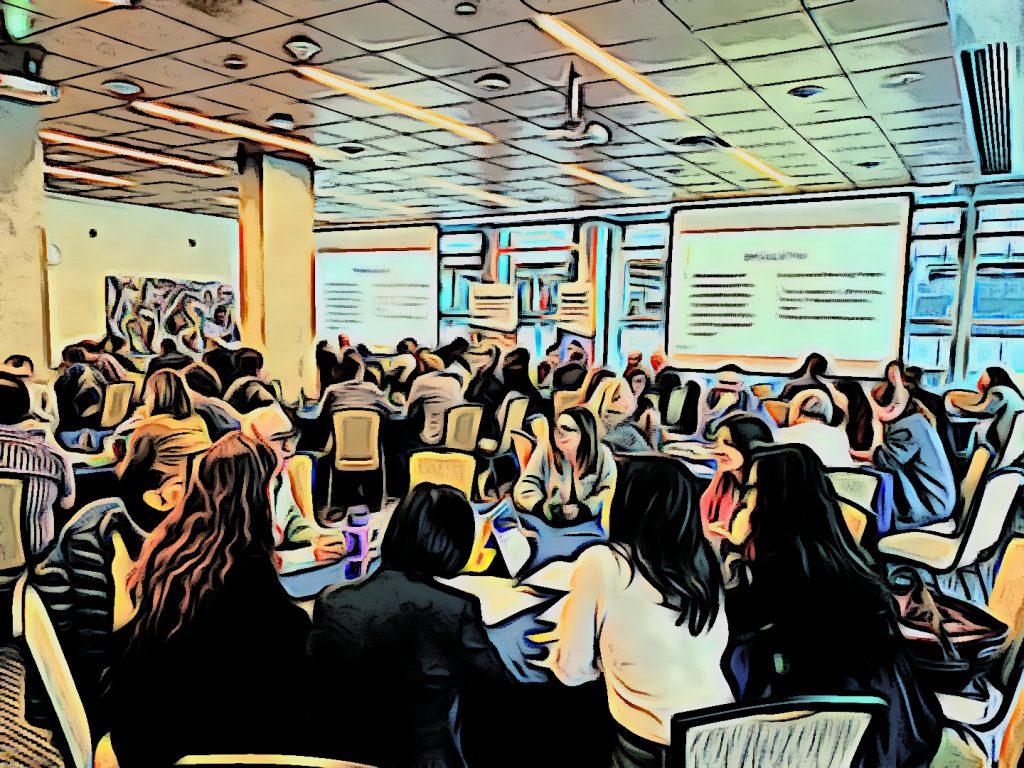On March 5th, 2020, I facilitated my last in-person session before the reality of COVID-19 struck. It was a great session with the client saying:
Thank you again for facilitating our event last Thursday. Our staff and external partners have provided nothing but positive feedback on the event and we were exceptionally pleased with the services you provided.
In this blog, I describe the in-person design and activities and explore how I might now facilitate it in the virtual setting.
90 participants, 60 minutes, 3 questions, 1-week notice … and the time for the session was from 5:30 to 6:30 p.m. at the end of the workday. Wow, a challenge!
- Client: a large upgrading and post-secondary college
- Event: a Business and Community Connect Mixer session
- Purpose: to gain ideas from internal college employees and external stakeholders about ways that the College faculty and students could use applied research to help businesses and community agencies.
- Participants: a diverse mix of business and community stakeholders and College employees, pre-assigned to 10 tables
The session format was:
- A ½ hour casual meet and greet time with refreshments
- An hour of presentations to inform the participants about applied research projects, and
- An hour facilitated discussion to gain input and ideas.

The three questions were:
- What industry and community problems exist that College faculty and students could help to solve through applied research?
- What collaborative applied research project ideas do you have?
- What is your interest in working with the College on applied research projects?
Here’s the in-person design for the one-hour facilitated discussion followed by a potential virtual design
- Explain the purpose and the process (5 minutes)
- Question 1: Identify problems in table discussions (20 minutes): Participants at each table shared problems facing business and community. They wrote three main problems and comments on a recording sheet. I invited three tables to briefly describe one problem to the entire group.
- Question 2: Ideas for projects through a stand and talk format; then return to the original table (25 minutes): Participants stood and moved around, forming groups of 4 to discuss ideas for four minutes; then formed new groups and discussed more ideas. Then, participants went back to their original tables and talked about their own ideas and what they had heard. They recorded projects ideas and comments on a recording sheet. I invited three tables to briefly describe one project idea.
- Question 3: Interest in future involvement: Each participant recorded her/his interest in further involvement on a recording sheet using these categories:
- interested in receiving information
- interested in future discussion events
- interested in pursuing a project
- Interest in specific project/s
- Not interested at this time
How could I transform the in-person session to a virtual one using Zoom Meetings?
The same format used for the in-person session could apply to a virtual setting with modified activities. Here are some ideas.
- Start with a welcome and then the presentations, reduced to 1/2 hour rather than an hour. Use polls to spark interest and ideas about the content.
- Create “table” groups with the 90 participants divided into breakout rooms and ask them to discuss Questions 1 and 2. Someone records the top three answers to bring to the plenary with one spokesperson for the breakout room. Record in the Chat or in a Googledoc or use an app like Mural or another online recording tool.
- For the moving activity, use roving breakout rooms. Start with 4 to 5 participants in a room; talk for 4 minutes; then re-create rooms and switch participants. Do several times. End with each group recording 3 top answers on a Google Doc or Mural app or another online recording tool.
- Hold smaller online video conferencing sessions by inviting 10 participants to a session and gathering their input.
A checklist for success in similar sessions, either in-person or virtual:
The following checklist applies to in-person and online sessions. Know the outcomes, design for diverse perspectives, keep it simple, provide clear instructions – these are fundamental design elements whether in-person or online.
Understand what the client wants.I held several telephone conversations and then met with three representatives of the College. We affirmed the session outcomes, ensuring that they were clear and attainable in the 60-minute session. I suggested a process and discussion techniques and the representatives and I finalized the design together.
Create clear and compelling questions. I listened to what the hosts wanted to achieve. Then, I wrote draft questions to reflect what they said. They reviewed and revised the questions; then I suggested one more change and we finalized them.
Keep it simple! Keep the design simple. I used two discussion techniques which allowed participants at the tables to delve into the topics and also allowed them to move and hear others from different tables.
Design for diverse perspectives. We intentionally assigned seating to mix College staff and business and community stakeholders. We cross-pollinated the discussions by using a move and talk activity for the second question. Organize to have as many diverse perspectives as possible within one hour. In the virtual setting, you could assign participants to breakout rooms.
Have clear and brief instructions: verbal and visual. One of the hosts acted as the emcee and provided clear, engaging, and interesting information and instructions throughout the session. In the virtual setting, have several hosts playing roles of facilitator, emcee, timekeeper, Chat and Q & A watcher, and technology guru.
We wrote the questions on tent cards placed on each table or have them on slides or whiteboards or googledocs in an online meeting.
I prepared four PowerPoint slides to show while I briefly and clearly explained the discussion activity. The room was large and had two pillars: so, enabling participants to see the instructions was helpful. For an online session, have the instruction slides available in many ways: on slides and screen share, in the Chat area, as instructions to the breakout rooms shared or described by a group facilitator, in a googledoc for capturing small group discussions.
We dimmed the room lights to let participants know to end the small group discussions. In a virtual setting, give a 30 to 60-second warning.
Allow participants to self-record. We created three recording sheets; one for each question and placed them on the tables. In a virtual format, share the recording sheet to each breakout group.
Enable participants to prioritize and theme their ideas. We asked the table groups to identify their top three priorities for each of the questions 1 and 2. This helped them to brainstorm and then look at similarities and make sense of their ideas. It also created a manageable amount of data for the College representatives to consider. And yes, I invited the groups to write more than three priorities if they wished.
Move! Even in one hour and with a large group, it is very easy to design for participants to move and talk. Doing so gives them a chance to talk with participants that may have other perspectives on the topics. In a virtual session, re-create the sense of moving by having several rounds of breakout rooms for discussion.
One hour and 90 participants and 3 questions! Yes, it can be done in-person or virtual! What sessions have you adapted to the virtual facilitation world?
